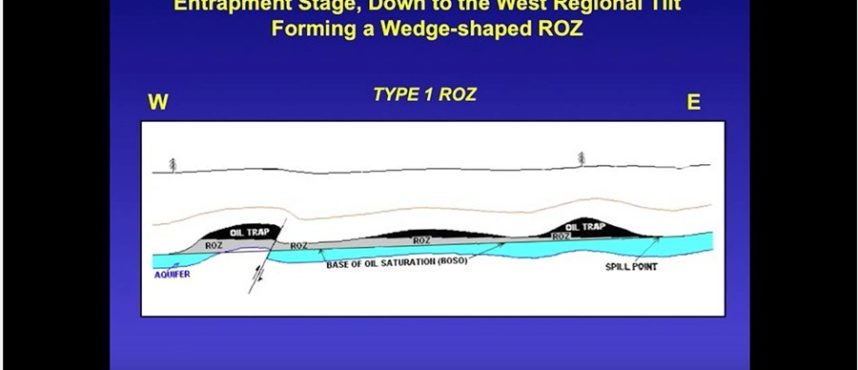Residual Oil Zone Type 1
The oil and gas industry has come to recognize now that oil reservoirs and the sub-surface can undergo multiple stages of tectonics beyond the original one, which involves burial, oil generation in the original entrapment stage where oil moved into a structurally high trap in the sub-surface. Those multiple stages of tectonics can take one of three different forms.
We are going to talk about the first kind of tectonic adjustment that occurs in the sub-surface, which moves the oil around and creates what we like to call a residual oil zone or ROZ, where water has invaded a former oil trap portion of a reservoir and the only oil left in that portion of the trap is that what we call residual oil that’s in the corners of the pore spaces or perhaps attached to the rock surface itself.
For the purposes of this discussion, we’ll walk through four slides in the first part and then go to animation to make it clear how this might work for ROZ type 1. What we’ve got in the first slide is a hypothetical origin entrapment that might have been formed many ages ago in the geological past, and what we’re going to do is, in the case of this first type of ROZ, we’re going tilt the left side (what we call the west side) of this hypothetical trap down and actually move oil out of the trap and displace a portion of that pore space (a wedge of that pore space) with water, that’s what we call type 1.
Type 2 is a different kind of readjustment due to tectonic activity, and it’s one that would activate a fault perhaps in the sub-surface and some of the oil or maybe all of the oil leaked out of that sub-surface trap (paleo trap/ original trap) and water invaded vertically from below and created a smaller trap or perhaps no trap at all.
The 3rd type of trap is what we call a type 3 ROZ, wherein we have a hydrodynamic gradient where we might move water from left to right and displace oil to the right, leading to a tilted oil-water contact. This particular type is very common in the Permian Basin.
Let’s go back to type one, and that’s what we’re going to concentrate on in this presentation, and we have an animation to help you understand how this might occur in the sub-surface. We have, in this case, a downward tilt; what we call the Westside is tilting downward, and you see the water encroach vertically upward into the former paleo trap, move the oil out, and let water into the pore spaces.
On the east, we’re losing oil past the spill points, going out to the east, probably to another entrapment—a secondary entrapment somewhere off to the east. In this case, the ROZ that’s formed is a wedge shape with its thickest side on the west, and the oil-water contact that was in the paleo trap has now moved down and forms the base of the ROZ, whereas the new oil-water contact which has to be horizontal, due to gravity effects creates the top of the ROZ. So, we have a wedge shape with its thickest side on the west side of the paleo trap, and that’s the target that we go after with enhanced oil recovery. When the oil saturation is sufficient, we can get that economically in today’s methods of EOR.
Contact Melzer Consulting at (432) 682-7664 or fill out our contact form for more information.

